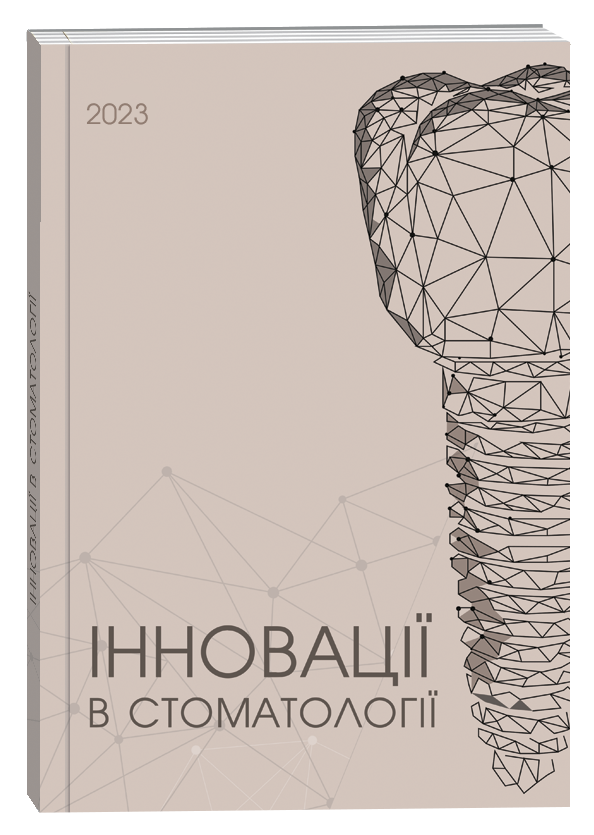EFFECT OF EXTREMELY HIGH FREQUENCY ON PERIODONTAL PATHOGENS IN SUBJECTS WITH GENERALIZED CHRONIC PERIODONTITIS
DOI:
https://doi.org/10.35220/2523-420X/2023.1.4Keywords:
generalized chronic periodontitis, periodontal pathogens, polymerase chain reaction, extremely high frequencies, periodontal tissuesAbstract
Periodontitis is an inflammatory disease caused by certain types of bacteria that colonize the area between the tooth surface and the edge of the gum. This condition causes destruction of the supporting tissues of the tooth, including connective tissue and alveolar bone, and can lead to tooth loss. Purpose of the study. The study is devoted to the research of the effect of extremely high frequencies on the number of periodontal pathogens in periodontal pocket samples of patients with chronic generalized periodontitis using the real-time polymerase chain reaction method. Materials and methods. The study involved 10 patients with chronic generalized periodontitis of the initial, 1st and 2nd stages (average age – 47 years). Exposure to extremely high frequencies was used as a pathogenetic therapy. The extremely high frequency emitter was applied directly to the gingival mucosa in the projection of the apices of the teeth roots. The duration of the procedure was 3-4 minutes for each exposure field. The presence and number of periodontal pathogens Aggregatibacter actinomycetemcomitans, Porphyromonas gingivalis, Porphyromonas endodontalis, Treponema denticola, Tannerella forsythia, Prevotella intermedia and Fusobacterium nucleatum were determined by real-time polymerase chain reaction. Among the periodontopathogens studied, the greatest quantitative presence was distinguished by A. actinomycetemcomitans: > 90% of all sample bacteria in 60% of samples of periodontal pocket contents in patients with generalized periodontitis. The use of HFE significantly reduced the number of P's. endodontalis in samples, which allows us to recommend HFE as one of the methods of complex treatment of chronic generalized periodontitis.
References
Jarvensivu, A., Hietanen, J., Rautemaa, R., Sorsa, T., & Richardson, M. (2004). Candida yeast in chronic periodontitis tissues and subgingival microbial biofilms in vivo. Oral Dis, 10, 106–12 doi: 10.1046/j.1354-523x.2003.00978.x.
Mineoka, T., Awano, S., Rikimaru, T., Kurata, H., Yoshida, A., Ansai, T., & et al. (2008). Site specific development of periodontal disease is associated with increased levels of Porphyromonas gingivalis, Treponema denticola, and Tannerella forsythia in subgingival plaque. J Periodontol., 79, 670–76 doi: 10.1902/jop.2008.070398.
Lombardo Bedran T.B., Marcantonio, R.A., Spin, Neto R., Alves Mayer, M.P., Grenier, D., Spolidorio, L.C., & Spolidorio, D.P. (2012). Porphyromonas endodontalis in chronic periodontitis: a clinical and microbiological cross-sectional study. J Oral Microbiol doi: 10.3402/jom.v4i0.10123.
Fine, D.H., Schreiner, H., & Velusamy, S.K. (2020). Aggregatibacter, A Low Abundance Pathobiont That Influences Biogeography, Microbial Dysbiosis, and Host Defense Capabilities in Periodontitis: The History of A Bug, And Localization of Disease. Pathogens, 2, 9(3), 179 /doi.org/10.3390/pathogens9030179.
Zolotuhina, O.L., Romanova, Ju.G., & Shnajder, S.A. (2020). Harakterystyka zmin mikroflory parodontal'nyh kyshen' pislja kompleksnogo likuvannja tjutjunozalezhnyh pacijentiv z hronichnym generalizovanym parodontytom na tli hronichnogo giperacydnogo gastrytu [Characteristics of changes in the microflora of periodontal pockets after complex treatment of tobacco-dependent patients with chronic generalized periodontitis on the background of chronic hyperacid gastritis]. Visnyk stomatologii – Bulletin of Dentistry, 3(112), 37, 30-35 doi 10.35220/2078-8916-2020-37-3-30-35.
Shiba, T., Komatsu, K., Sudo, T., Sawafuji, R., Saso, A., Ueda, S., Watanabe, T., & et al. (2021). Comparison of Periodontal Bacteria of Edo and Modern Periods Using Novel Diagnostic Approach for Periodontitis With Micro-CT. Front Cell Infect Microbiol., 20, 11, 723821 doi: 10.3389/fcimb.2021.723821.
Kumar, P.S., Griffen, A.L., Barton, J.A., Paster, B.J., Moeschberger, M.L., & Leys, E.J. (2003). New bacterial species associated with chronic periodontitis. J Dent Res., 82, 338–44 doi: 10.1177/154405910308200503.
Ashimoto, A., Chen, C., Bakker, I., & Slots, J. (1996). Polymerase chain reaction detection of 8 putative periodontal pathogens in subgingival plaque of gingivitis and advanced periodontitis lesions. Oral Microbiol Immunol., 1, 266–73 doi: 10.1111/j.1399-302x.1996. tb00180.x.
Henderson, B., Ward, J.M., & Ready. D. (2010). Aggregatibacter (Actinobacillus) actinomycetemcomitans: a triple A* periodontopathogen? Periodontol. 2000, 54, 78–105 doi: 10.1111/j.1600-0757.2009.00331.x.
Fine. D.H., Markowitz, K., Furgang, D., Fairlie, K., Ferrandiz, J., Nasri, C., McKiernan, M., & Gunsolley, J. (2007). Aggregatibacter actinomycetemcomitans and its relationship to initiation of localized aggressive periodontitis: longitudinal cohort study of initially healthy adolescents. J Clin Microbiol, 45, 3859–3869 doi: 10.1128/JCM.00653-07.
Haubek, D., Ennibi, O-K., Poulsen, K., Væth, M., Poulsen, S., & Kilian, M. (2008). Risk of aggressive periodontitis in adolescent carriers of the JP2 clone of Aggregatibacter (Actinobacillus) actinomycetemcomitans in Morocco: a prospective longitudinal cohort study. Lancet, 371, 237–242 v doi: 10.1016/S0140-6736(08)60135-X.
Sánchez-Villamil, J.P., Pino-Vélez, C., Trejos-Suárez, J., Cardona, N., España, A.L., & Alfonso, P.A. (2020). Salivary markers of oxidative stress and periodontal pathogens in patients with periodontitis from Santander, Colombia. Biomedica, 40, 113–124 doi: 10.7705/biomedica.5149.
Rahamat-Langendoen, J.C., van Vonderen, M.G.A., Engström, L.J., Manson, W.L., van Winkelhoff, A.J., & Mooi-Kokenberg, EANM. (201)1. Brain abscess associated with Aggregatibacter actinomycetemcomitans: case report and review of literature. J Clin Periodontol, 38, 702–706 doi: 10.1111/j.1600-051X.2011.01737.x.
Zambon, J/J. (1985). Actinobacillus actinomycetemcomitans in human periodontal disease. J Clin Periodontol, 12, 1–20 doi: 10.1111/j.1600-051x.1985.tb01348.x.
Lombardo Bedran, T.B., Marcantonio, R.A., Spin, Neto R., Alves, Mayer M.P., Grenier, D., Spolidorio, L.C., & Spolidorio, D.P. (2012). Porphyromonas endodontalis in chronic periodontitis: a clinical and microbiological crosssectional study. J Oral Microbiol., 4 doi: 10.3402/jom.v4i0.10123. Epub 2012 Jan 5.








